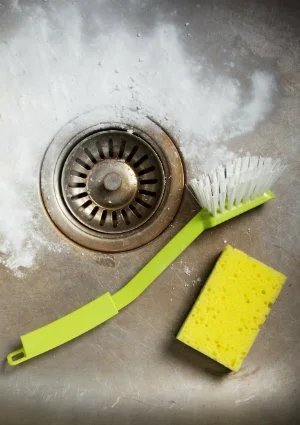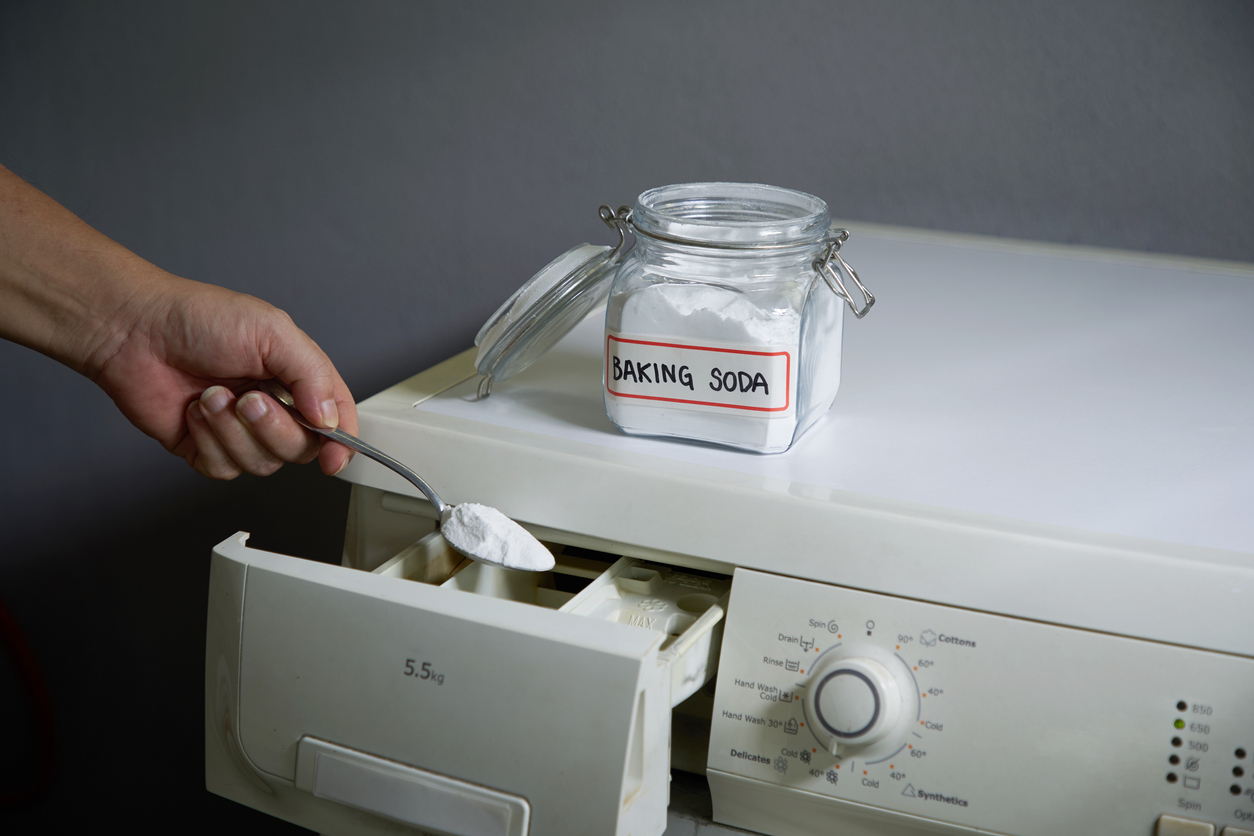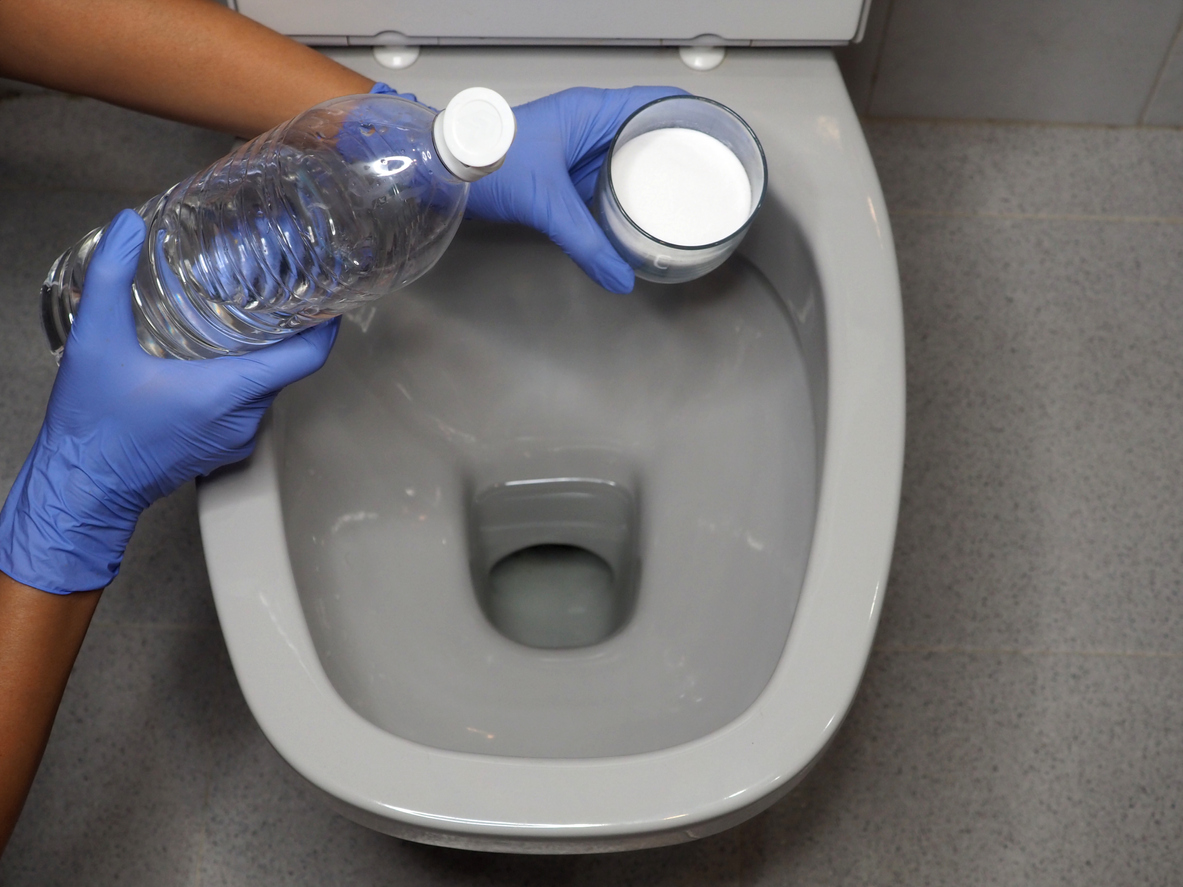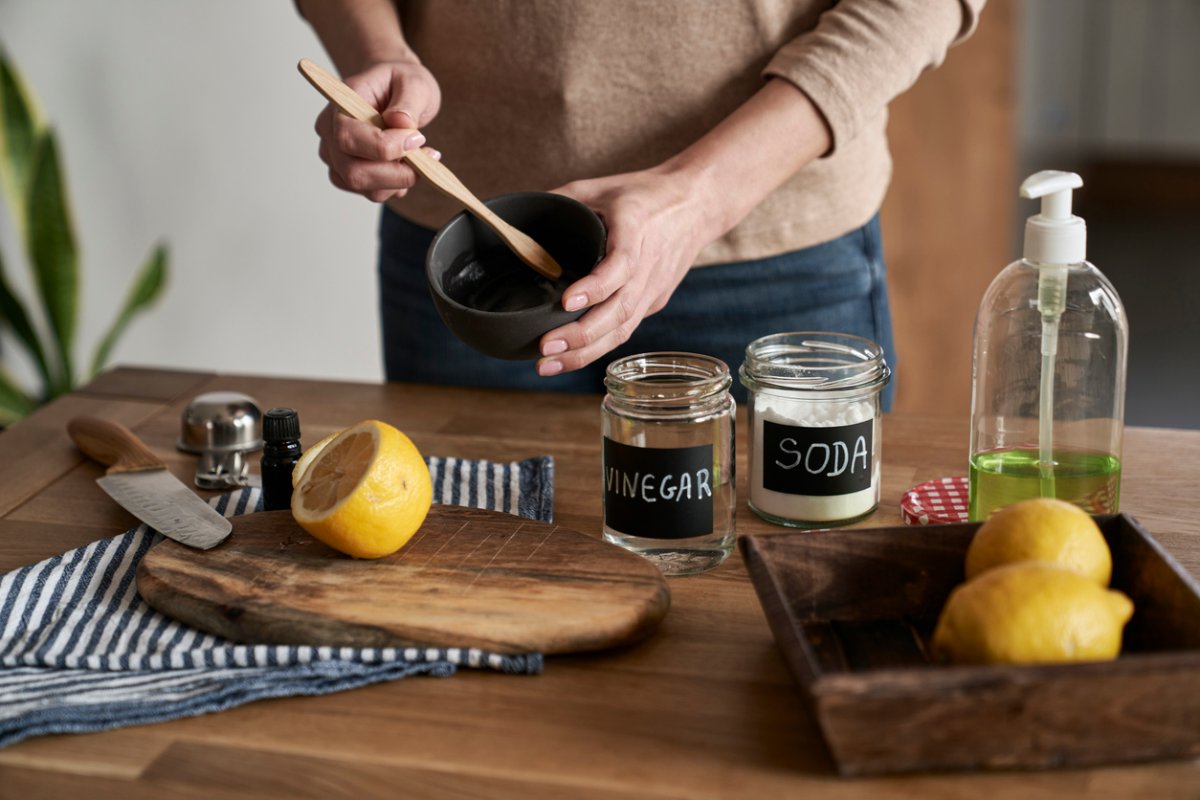We may earn revenue from the products available on this page and participate in affiliate programs. Learn More ›
It turns out our grandmothers were right: There’s little need for store-bought, chemical cleaners given that baking soda and vinegar are each natural, inexpensive ways to freshen the home. When the ingredients are combined, however, they produce a natural chemical reaction that’s powerful enough to scrub and scour bathrooms, kitchens, and other grimy zones. What are the best ways to put these pantry essentials to use, and why do they work so well together?
What happens when you mix baking soda and vinegar?
Commercial cleaners typically contain strong, even harmful, chemicals. Using green cleaning methods can reduce toxins inside your home, and in the environment. The interesting thing about combining vinegar and baking soda is that it creates a chemical reaction, but a natural one that produces no airborne toxins. The simple use of these two household staples is more than handy and natural; it’s strong science.
Vinegar and baking soda represent opposite sections of the pH scale, with vinegar extremely acidic and baking soda at a higher, or alkaline, end. As soon as they mix, they exchange molecules and a complex reaction occurs, which leads to the fizzy substance that represents the creation of water and carbon dioxide, a nonflammable gas. The reaction happens the instant the acid (vinegar) hits the base (baking soda).
Separately, both vinegar and baking soda work well for cleaning. Alone, baking soda can dissolve grease and dirt, while distilled white vinegar breaks down minerals without adding any coloring to stain surfaces (as apple cider vinegar might). However, it’s the fizzy baking soda and vinegar reaction that makes the dynamic duo such an effective and versatile cleaning agent, since the fizz can attack stains. In other words, white vinegar and baking soda create a safe and green cleaning solution, performing best as a team.

1. Freshen a kitchen drain (and shine a stainless steel sink).
Instead of using harsh chemicals that could potentially damage your pipes, unclog a drain and refresh it by pouring in a homemade drain cleaner made up of ½ cup of baking soda and 1 cup of vinegar. Always keep the ratio one-part baking soda to two parts vinegar for the best drain cleaner for kitchen sink gunk. The natural drain cleaner mixture will fizz and bubble, like your favorite middle school volcano science project. Once it dies down, flush the drain with very hot water for 5 minutes, then run the cold water.
After completing the clogged drain home remedy, take the opportunity while the surface is damp to sprinkle extra baking soda in the basin of the sink. Give it a good scrub using a scrub brush or dish sponge. The slightly abrasive qualities of the baking soda should help to remove stuck-on gunk and stains.
2. Remove hard water stains.
Give tough, hard water stains the boot: Place a cloth or paper towel soaked with vinegar over the affected area and let it sit for a few hours. Remove the cloth, scrub with a baking soda paste (a mixture of dry baking soda and just enough water to create a paste-like consistency), spritz lightly with vinegar, and wipe clean.
3. Reverse carpet stains.
With these cleaners up your sleeve—or, rather, sitting in your pantry—you need not cringe when a guest spills a bit of drink on your carpet. Create a paste with baking soda and a small amount of vinegar, then work it into the stained carpet fibers with your fingers. Allow the mixture to sit and dry overnight, then vacuum up any remnants. Before trying out this tip on a large area, test it on a small, out-of-sight patch of carpet first. If everything looks kosher, treat the rest of your stain.
RELATED: Buyer’s Guide: The Best Natural Cleaning Products
4. Kill mildew in a load of laundry.

The baking soda and vinegar reaction’s cleaning and deodorizing properties work wonders in the wash. Add ½ cup of baking soda in with your detergent to help boost its cleaning power. One cup of vinegar poured in during the rinse cycle will help kill bacteria in the load and doubles as a chemical-free fabric softener.
Baking soda and vinegar also can help remove soap scum and mildew from a shower curtain right in your washing machine. A vinegar cleaning solution is a natural first step in removing mildew without resorting to harsh bleach.
5. Whiten and brighten grout.
The abrasive qualities of baking soda add muscle to your own scrubbing efforts. Nowhere could use that extra “oomph” more than your stained grout! Make a paste using baking soda and water, spritz lightly with vinegar, and immediately scrub and rinse the area. Full disclosure: You’ll probably still need a little bit of muscle—just think of these power players as your line of backup.
6. Get rid of gunk on pots and pans.
Dried-on food particles, baked-on grime, and burnt dinner remains all can add time on to your dinner cleanup—but they’re no match for this power couple. Sprinkle baking soda on damp (not wet) pots and pans, spritz with vinegar, then go to town scrubbing with a nylon dish sponge. The slight foaming action will break up some of the tougher stuck-on food, leaving you with a little extra energy after dish duty.
7. Unclog a toilet.

As with the sink drain, use baking soda and vinegar to unclog toilet minor backups without turning to the harsh chemicals in commercial drain cleaners. If the toilet bowl water level is high, bail out some water first. Then pour a cup of baking soda and a cup of white vinegar down the toilet’s drain. You should see it bubble up. Wait about 30 minutes and pour hot water into the bowl to see if it drains. It’s OK to repeat these steps if you see some loosening, but need a little more clog removed.
It also is OK to leave the vinegar and baking soda mixture in the toilet overnight; neither baking soda nor white vinegar will damage clogged pipes. In fact, vinegar alone can clean a toilet tank. It also is OK to use a plunger with the solution on tough clogs. If these steps fail, however, it might be time to call in a plumber.
RELATED: 7 Clever Ways to Unclog a Toilet Without a Plunger
8. Get rid of grease.
Baking soda is known as an extinguisher of small grease fires, reacting with heat to produce carbon dioxide and help smother flames. Combine it with vinegar to remove nasty and stubborn grease on many surfaces (beware, though, that baking soda can be too harsh for ceramic glass or marble). Spray full-strength vinegar on first and let it sit for a few minutes. Wipe the area with a nonabrasive cloth or sponge. If any stains remain, sprinkle baking soda on a damp sponge and scrub. Then wipe with a clean wet cloth to rinse.
Those who want to know how to clean the oven without oven cleaner can combine ¾ cup baking soda, ¼ cup of noniodized salt, and ¼ cup water to form a paste. Spread it on the inside of the oven, avoiding metal parts or openings. Leave the paste on overnight, then scrape the hardened solution off with a plastic spatula. Wipe it clean, and attack remaining stubborn spots by gently rubbing steel wool on the stain.
9. Polish silverware.
If you pull out your best silverware or serving dishes before company comes, you might find a buildup of tarnish. The darkening occurs when sulfur-containing gases release into the air and react with silver on its surface. To polish silverware with baking soda and vinegar, pour a tablespoon of baking soda into a disposable aluminum pan and slowly add ½ cup of white vinegar. Then pour in a cup of boiling water and leave the silverware in the pan for 30 seconds to a minute. The silver reacts chemically with the baking soda and aluminum to clean the utensils.
For larger pieces, grab baking soda as a green alternative to commercial silver polish. With water and about ½ box of baking soda, stir to create a paste that is just slightly runny. Dip a clean, soft cloth or sponge into the paste and rub it on the tarnished silver. Leave the paste on for about 1 minute to 10 minutes, depending on the severity of the tarnish.
10. Clean and deodorize the garbage can.
A known natural odor absorber, baking soda can help deodorize that stinky everyday garbage can. Covering the inside bottom of the can beneath the plastic bag or liner can help tackle up to 70 percent of odors. Or, combine 2 cups of baking soda with tea tree oil in a small bowl with a fork to get rid of lumps. Sprinkle the mixture on the can bottom under the liner. Be sure to change it out periodically.
To keep odors from forming and to clean the can, rinse it periodically with white vinegar and leave it outside in the sun to dry. For stubborn gunk, use a solution of baking soda and water to scrub the can before rinsing with the vinegar.
